Leading successful projects requires efficient time and event management in all types of life endeavors. Thankfully, Windows 11 comes with a wide range of calendar management software options that can assist you in keeping organized, setting up appointments, and reminding significant events. These seven calendar management software options are sure to meet your needs, whether you’re a busy individual trying to improve time management or a professional looking to streamline your workflow.
Contents
Microsoft Outlook
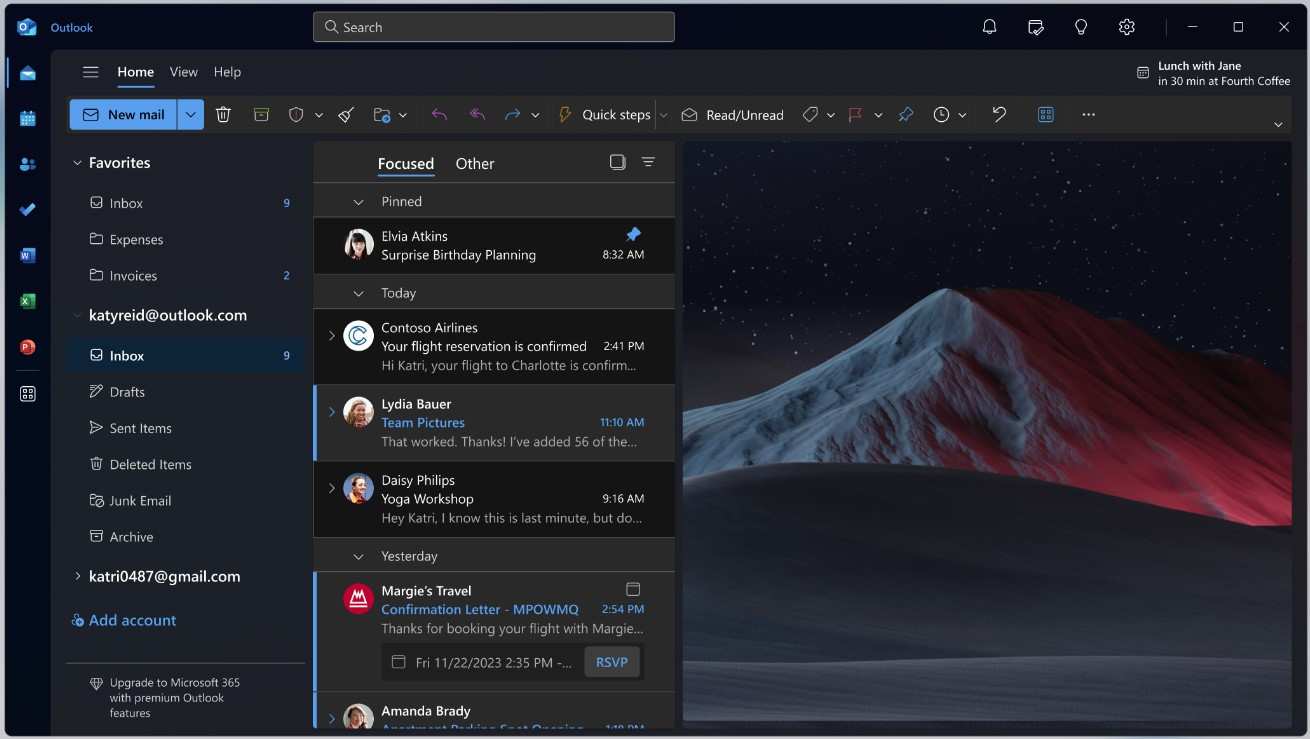
For millions of people, Microsoft Outlook is the cornerstone of productivity because of its seamless interface integration of contacts, calendar, email, and tasks. Outlook was first released in the 1990s and has since developed into a vital tool for managing both personal and professional life. It replaces the now-defunct Windows Calendar app and comes pre-installed with Windows 11, guaranteeing its widespread use throughout Microsoft’s ecosystem.
Outlook’s ability to integrate its apps seamlessly is why many of us are so customed to this app. It makes email conversations into meeting invitations that automatically appear on users’ calendars, enabling smooth transitions from email to scheduling. This synergy goes even further, facilitating simple appointment scheduling between coworkers in businesses that use Exchange calendar sharing.
Even though Outlook’s interface can occasionally seem crowded, especially in the calendar pane, its functionality is still strong. There are options for day, week, month, or schedule views, and users can easily switch between monthly views, upcoming appointments, and open calendars. With mouse clicks or keyboard shortcuts, adding appointments is a breeze, improving time management efficiency.
In addition to its built-in support for Exchange and Microsoft 365 calendars, Outlook allows users to sync with Google and Yahoo calendars. Furthermore, by connecting to thousands of additional services through Zapier’s integrations, Outlook expands its functionality and gives users the ability to automate processes and increase productivity.
OneCalendar
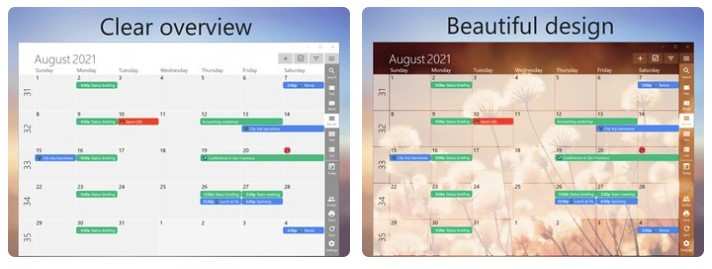
OneCalendar is a notable competitor in the field of calendar applications because of its strong functionality, which more than makes up for its lack of aesthetic appeal. Its strength lies in its seamless synchronization with almost every calendar platform imaginable, despite its less-than-modern appearance from Windows 8.
The interface greets users with a calendar-centric design that prioritizes the display of appointments. It also provides a flexible toolbar for switching between different views, such as day, week, month, year, and list. To further accommodate personal preferences, the sidebar can be hidden, further customizing the experience.
Interestingly, OneCalendar supports a staggering number of platforms—from Google and Microsoft to iCloud, Yahoo, CalDAV, and more. Because of its compatibility with a wide range of user preferences, it is compatible with lesser-known services like WebCal, mailbox.org, Synology, and ownCloud and is therefore inclusive.
The ease with which appointments can be added and viewed straight from the Windows lock screen is greatly appreciated. Although the free version only provides basic functionality, users looking for more personalization and usefulness can access extra features like custom colors and printing capabilities by upgrading to the premium tier.
Mozilla Thunderbird
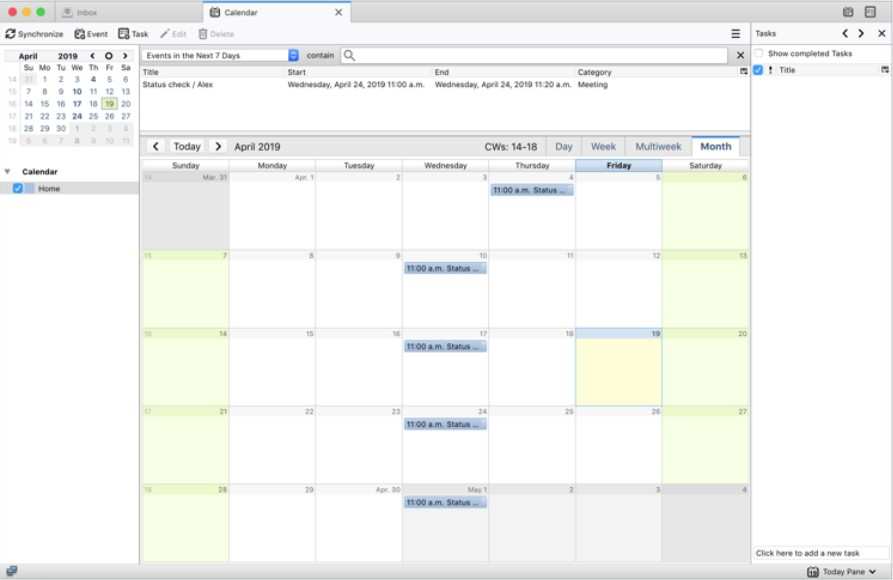
Popularly known as an email client, Mozilla Thunderbird also has a powerful built-in calendar feature that enhances its usefulness as an all-around organizer and communication tool. Thunderbird’s dedication to accessibility is demonstrated by the fact that it is not only entirely free but also open-source, encouraging community contributions and supporting a thriving ecosystem of extensions.
Although Thunderbird’s primary interface might seem disorganized to some, its calendar features are effective and adaptable. Users can easily switch between various time periods thanks to the interface’s smooth presentation of monthly calendar views, upcoming appointments, and conventional calendar displays.
Thunderbird’s calendar view can be set to show days, weeks, multiple weeks, or months, depending on your preferences. Whether using keyboard shortcuts or mouse interactions, adding appointments is made more efficient, improving user productivity and convenience.
Before, it was difficult to integrate third-party services into Thunderbird, such as Google Calendar. However, newer versions of Thunderbird have made this process easier and allow access right away after logging in. In addition, Thunderbird’s open-source design attracts a vibrant developer and enthusiast community that consistently improves its functionality with community-developed add-ons. With these extensions, users can customize anything from specialized views like Gantt charts to online calendar support, giving them unmatched flexibility.
Monday.com
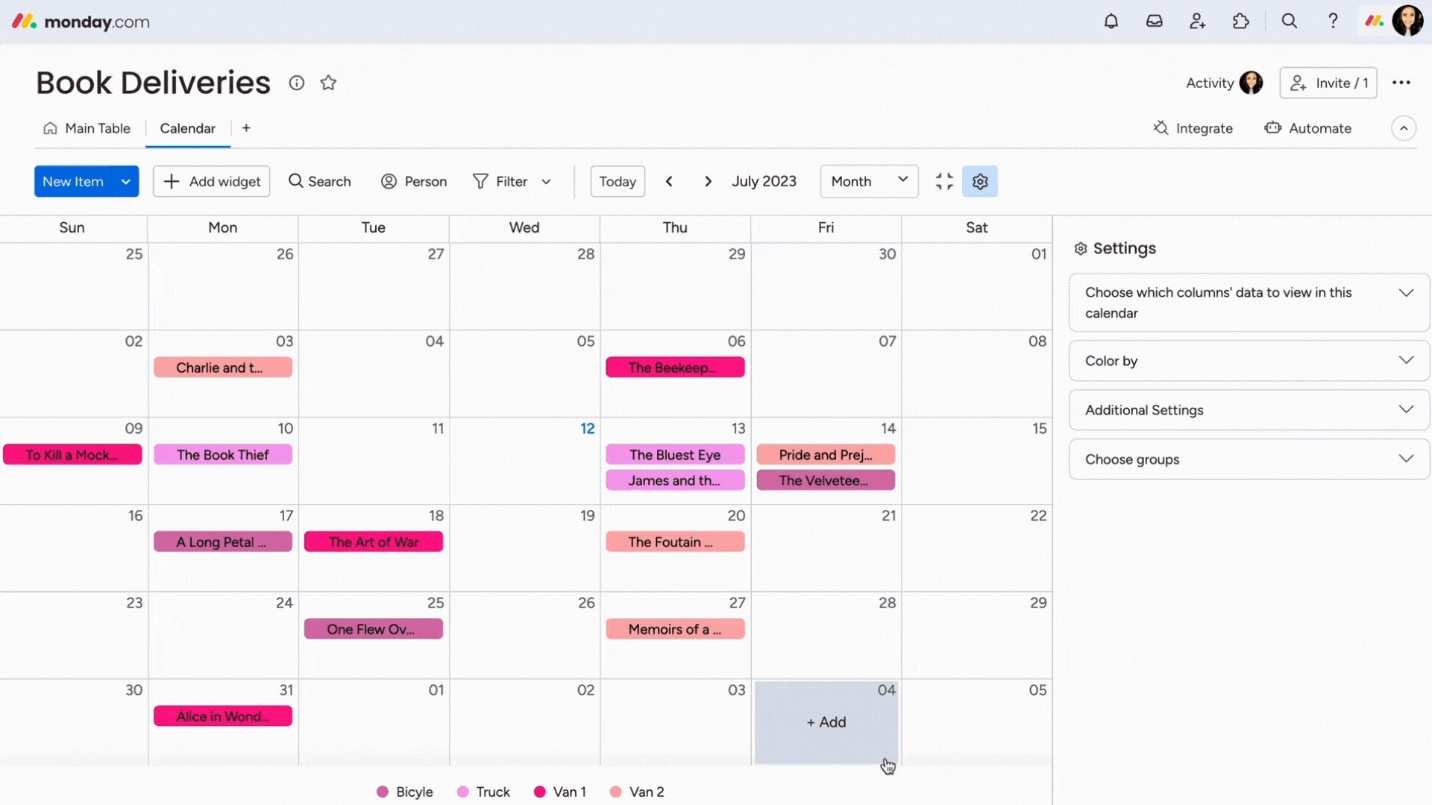
Like a series of highly configurable spreadsheets designed for team collaboration, Monday.com is a dynamic online platform for work management and collaboration. Its sleek, contemporary interface makes it simple to use and navigate, which attracts teams looking for project management that is streamlined.
Most actions on the platform only require one or two clicks, thanks to its intuitive design, which guarantees responsiveness. Drag-and-drop functionality is advantageous as it allows users to easily rearrange elements. Tools for comments and discussions are similar to social media interfaces, making communication within teams easy.
Board folders on Monday.com help users efficiently organize their boards by classifying and managing them based on their desired level of visibility. Boards can be kept private for personal use, shared with outside clients, or accessible to all team members.
Examining the various views that are accessible improves the adaptability of the platform. The Calendar view works well with tasks that are specific to a given date, while the default Table view, which resembles a spreadsheet, offers a thorough overview. The Map view also provides spatial organization, which is especially helpful for tasks that have a physical location.
Although there are other platforms that provide more straightforward subscription options and extensive free plans, Monday.com stands out due to its intuitive interface, adaptable features, and flexible views, making it a great choice for teams looking for effective project management and collaboration solutions.
Mail and Calendar

A promising addition to the Windows 11 ecosystem was the Window’s Mail and Calendar. It offers a plethora of features aimed at effective productivity and organization. Presenting itself as a highly configurable and feature-rich calendar app, it offers a plethora of features aimed at improving user experience and optimizing task delegation.
With its flexible calendar views—month, week, and day—the app offers users the flexibility to quickly switch between different viewpoints to suit a wide range of preferences. The calendar is enhanced with contextual information by displaying holidays, birthdays, special days, and name days in certain countries, among other noteworthy features.
Many customization options enable users to personalize calendar views to their preference, and multiple Live Tile styles further enhance customization. Furthermore, users have the ability to choose which calendars are visible from all of the options on their device, which guarantees flexibility in handling a variety of schedules and obligations.
Although the free version with ads provides good functionality, the Pro Pack unlocks more features like task management, an integrated birthday calendar with photos, and improved calendar views like Today, Agenda, and Year.
Nevertheless, Windows Calendar has a major disadvantage, which is the end of support by the end of 2024. The fact that Microsoft has decided to move calendar integration only to Microsoft Outlook starting in 2025 highlights how short this otherwise excellent program’s life is. In spite of this drawback, Windows Calendar is still a strong option for Windows 11 users looking for an advanced and adaptable calendar solution while they wait.
Rainlendar
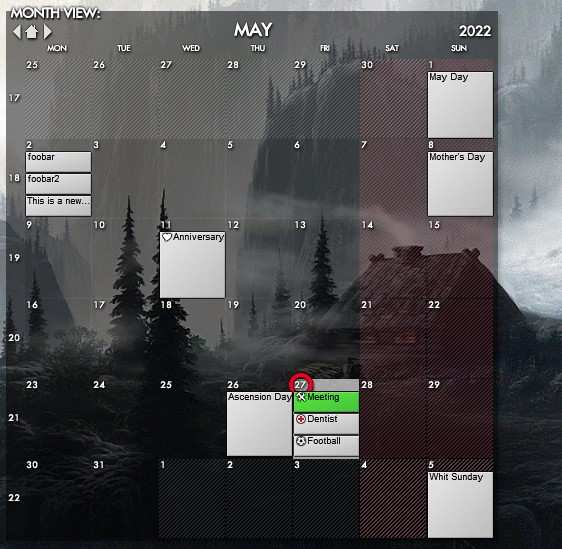
Rainlendar is a superb desktop calendar and reminder app that provides users with a straightforward yet efficient organizational tool. With a semitranslucent calendar and to-do list that blend in perfectly with the desktop environment, its well-known layout and simple interface make it a joy to use.
Because of the program’s simple menu structure and commands, navigating around it feels like utilizing Microsoft Outlook. With just a few mouse clicks and the entry of pertinent times and dates, setting up task lists and alarms is a simple process. With customizable sound alerts and a prominent screen appearance, reminders are made to be easily overlooked.
The hot-keys feature of Rainlendar Lite is one of its best qualities; it lets users designate shortcuts for easy access, decreasing the need for the mouse and improving task management efficiency. This feature adds to the application’s overall usefulness, effectiveness, and simplicity.
Rainlendar Lite is a freeware program that provides strong functionality without requiring a financial commitment. Although it may leave behind folders after removal, it’s still important to keep in mind given the program’s convenience and usefulness.
Google Calendar
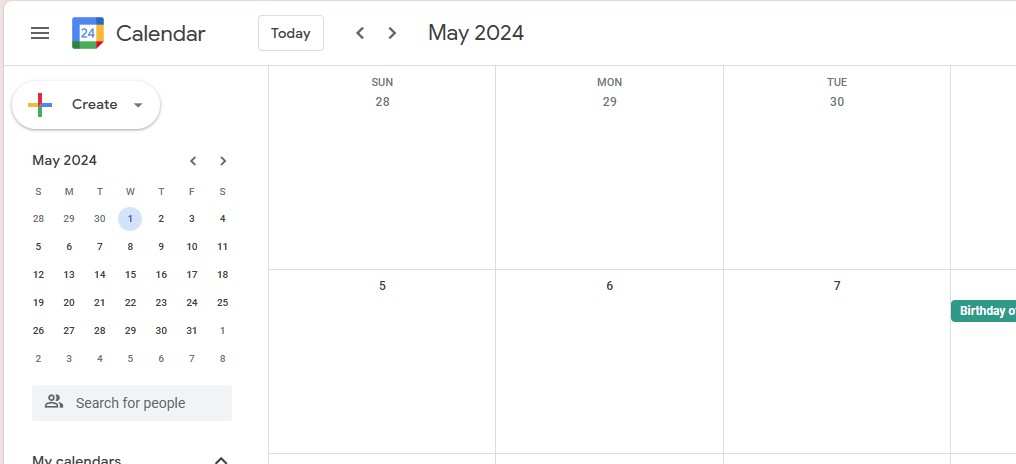
Google Calendar offers cross-platform accessibility and seamless integration with the entire Google product suite. Google Calendar is a flexible tool for managing schedules that is accessible on the web and on Android and ChromeOS devices. Windows users can also use Google Calendar on any choice of their browser effectively making this tool a suitable contender in this list.
Google Calendar has a clean appearance thanks to its professional and straightforward design. It provides a variety of viewing options, ranging from daily to annual views. Even though the interface has an unmistakable aesthetic appeal, some advanced users might find it difficult to find certain settings and options.
Google Calendar’s ability to integrate with other Google services is one of its main advantages because it makes coordination between different platforms easy. The calendar is automatically updated with events like flights and video calls from Gmail and Google Meet, which maximizes productivity and reduces manual entry.
Because Google Calendar is cloud-based, synchronization across all devices is guaranteed, giving users access to their schedules from any location at any time. Users can depend on Google Calendar to help them stay organized and on schedule whether using it on a desktop computer or a mobile device.
Google Calendar is a compelling option for both personal and business use, even though the basic features are free. Additional functionalities can be unlocked by subscribing to Google Workspace. Even in a time when artificial intelligence that saves time is given priority, Google Calendar is still a dependable tool for effective task management and scheduling.
Conclusion
Managing your calendar well is essential to reaching your objectives and increasing productivity. There is a calendar management software option for every need and preference, whether you prefer Monday.com’s collaborative features or Microsoft Outlook’s seamless integration. Investigate these seven choices to determine which one on Windows 11 best fits your workflow and increases your productivity.



